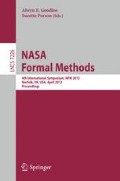Abstract
A systematic tool-based method is outlined that raises questions about the circumstances surrounding an incident: why it happened and what went wrong. The approach offers a practical and systematic way to apply a distributed cognition perspective to incident investigations, focusing on how available information resources (or the lack of them) may shape user action, rather than just on causal chains. This perspective supports a deeper understanding of the more systemic causes of incidents. The analysis is based on a higher order-logic model describing how information resources may have influenced the actions of those involved in the incident. The PVS theorem proving system is used to identify situations where available resources may afford unsafe user actions. The method is illustrated using a healthcare case study.
Access this chapter
Tax calculation will be finalised at checkout
Purchases are for personal use only
Preview
Unable to display preview. Download preview PDF.
References
Fluorouracil incident in PVS (December 2011), http://tinyurl.com/PVS-fluorouracil
Australian Transport Safety Bureau. Analysis, causality and proof in safety investigations, ATSB transport safety research report, AR-2007-053 (2007)
ISMP Canada. Fluorouracil incident root cause analysis report, http://www.ismp-canada.org/download/reports/FluorouracilIncidentMay2007.pdf
Zhang, J., et al.: Using usability heuristics to evaluate patient safety of medical devices. Journal of Biomedical Informatics, 36 (2003)
Hollnagel, E.: Barriers and accident prevention. Ashgate, Aldershot (2004)
Hutchins, E.: Cognition in the Wild. new edn. The MIT Press (1995)
Johnson, C.W.: Failure in Safety-Critical Systems: A Handbook of Accident and Incident Reporting. University of Glasgow Press, Glasgow (2003)
Johnson, C.W., Holloway, C.M.: A survey of logic formalisms to support mishap analysis. Reliability Engineering & System Safety 80(3), 271–291 (2003)
Ladkin, P., Sieker, B., Sanders, J.: Safety of Computer-Based Systems. Springer, Heidelberg (draft version from July 27, 2011)
Leveson, N.: A new accident model for engineering safer systems. Safety Science, 237–270 (2004)
Owre, S., Rushby, J.M., Shankar, N.: PVS: A Prototype Verification System. In: Kapur, D. (ed.) CADE 1992. LNCS (LNAI), vol. 607, pp. 748–752. Springer, Heidelberg (1992)
Reason, J.T.: Human error. Cambridge University Press (1991)
Vernez, D., Buchs, D., Pierrehumbert, G.: Perspectives in the use of coloured Petri Nets for risk analysis and accident modelling. Safety Science, 41(5) (2003)
Author information
Authors and Affiliations
Editor information
Editors and Affiliations
Rights and permissions
Copyright information
© 2012 Springer-Verlag Berlin Heidelberg
About this paper
Cite this paper
Masci, P., Huang, H., Curzon, P., Harrison, M.D. (2012). Using PVS to Investigate Incidents through the Lens of Distributed Cognition. In: Goodloe, A.E., Person, S. (eds) NASA Formal Methods. NFM 2012. Lecture Notes in Computer Science, vol 7226. Springer, Berlin, Heidelberg. https://doi.org/10.1007/978-3-642-28891-3_27
Download citation
DOI: https://doi.org/10.1007/978-3-642-28891-3_27
Publisher Name: Springer, Berlin, Heidelberg
Print ISBN: 978-3-642-28890-6
Online ISBN: 978-3-642-28891-3
eBook Packages: Computer ScienceComputer Science (R0)

